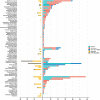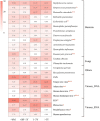Metagenomic-based pathogen surveillance for children with severe pneumonia in pediatric intensive care unit
- PMID: 37397737
- PMCID: PMC10309210
- DOI: 10.3389/fpubh.2023.1177069
Metagenomic-based pathogen surveillance for children with severe pneumonia in pediatric intensive care unit
Abstract
Background: Pneumonia is a significant cause of morbidity and mortality in children. Metagenomic next-generation sequencing (mNGS) has the potential to assess the landscape of pathogens responsible for severe pulmonary infection.
Methods: Bronchoalveolar lavage fluid (BALF) samples of 262 children with suspected pulmonary infections were collected from April 2019 to October 2021 in the Pediatric Intensive Care Unit (PICU) of Guangdong Women and Children Hospital. Both mNGS and conventional tests were utilized for pathogen detection.
Results: A total of 80 underlying pathogens were identified using both mNGS and conventional tests. Respiratory syncytial virus (RSV), Staphylococcus aureus and rhinovirus were the most frequently detected pathogens in this cohort. The incidence rate of co-infection was high (58.96%, 148/251), with bacterial-viral agents most co-detected. RSV was the main pathogen in children younger than 6 months of age, and was also commonly found in older pediatric patients. Rhinovirus was prevalent in children older than 6 months. Adenovirus and Mycoplasma pneumoniae were more prevalent in children older than 3 years than in other age groups. Pneumocystis jirovecii was detected in nearly 15% of children younger than 6 months. Besides, influenza virus and adenovirus were rarely found in 2020 and 2021.
Conclusions: Our study highlights the importance of using advanced diagnostic techniques like mNGS to improve our understanding of the microbial epidemiology of severe pneumonia in pediatric patients.
Keywords: PICU; co-infection; mNGS; pathogens; severe pneumonia.
Copyright © 2023 Li, Wang, Yao, Liao, Su, Yang, Xie and Zheng.
Conflict of interest statement
JW, XY, and MX were employed by Hugobiotech. The remaining authors declare that the research was conducted in the absence of any commercial or financial relationships that could be construed as a potential conflict of interest.
Figures



Similar articles
-
Utilizing metagenomic next-generation sequencing for diagnosis and lung microbiome probing of pediatric pneumonia through bronchoalveolar lavage fluid in pediatric intensive care unit: results from a large real-world cohort.Front Cell Infect Microbiol. 2023 Aug 15;13:1200806. doi: 10.3389/fcimb.2023.1200806. eCollection 2023. Front Cell Infect Microbiol. 2023. PMID: 37655299 Free PMC article.
-
Metagenomic next-generation sequencing of bronchoalveolar lavage fluid from children with severe pneumonia in pediatric intensive care unit.Front Cell Infect Microbiol. 2023 Mar 16;13:1082925. doi: 10.3389/fcimb.2023.1082925. eCollection 2023. Front Cell Infect Microbiol. 2023. PMID: 37009495 Free PMC article.
-
Diagnostic value of bronchoalveolar lavage fluid metagenomic next-generation sequencing in pediatric pneumonia.Front Cell Infect Microbiol. 2022 Oct 27;12:950531. doi: 10.3389/fcimb.2022.950531. eCollection 2022. Front Cell Infect Microbiol. 2022. PMID: 36389175 Free PMC article.
-
Diagnostic value of metagenomic next-generation sequencing of bronchoalveolar lavage fluid for the diagnosis of suspected pneumonia in immunocompromised patients.BMC Infect Dis. 2022 Apr 29;22(1):416. doi: 10.1186/s12879-022-07381-8. BMC Infect Dis. 2022. PMID: 35488253 Free PMC article.
-
Case Report: Metagenomic next-generation sequencing assists in dynamic pathogen monitoring: powerful tool for progressing severe pneumonia.Front Cell Infect Microbiol. 2023 Sep 4;13:1230813. doi: 10.3389/fcimb.2023.1230813. eCollection 2023. Front Cell Infect Microbiol. 2023. PMID: 37743869 Free PMC article. Review.
Cited by
-
Diagnostic value of metagenomic next-generation sequencing using bronchoalveolar lavage fluid samples for pathogen detection in children with severe or refractory pneumonia.Microbiol Spectr. 2025 Mar 4;13(3):e0108724. doi: 10.1128/spectrum.01087-24. Epub 2025 Feb 4. Microbiol Spectr. 2025. PMID: 39902982 Free PMC article.
-
Pathogen surveillance and risk factors for pulmonary infection in patients with lung cancer: A retrospective single-center study.Open Med (Wars). 2025 Apr 30;20(1):20251180. doi: 10.1515/med-2025-1180. eCollection 2025. Open Med (Wars). 2025. PMID: 40322468 Free PMC article.
-
Utilizing metagenomic next-generation sequencing for diagnosis and lung microbiome probing of pediatric pneumonia through bronchoalveolar lavage fluid in pediatric intensive care unit: results from a large real-world cohort.Front Cell Infect Microbiol. 2023 Aug 15;13:1200806. doi: 10.3389/fcimb.2023.1200806. eCollection 2023. Front Cell Infect Microbiol. 2023. PMID: 37655299 Free PMC article.
-
Clinical Features and Value of Tracheal Aspirate Metagenomic Next-Generation Sequencing for Severe Pneumonia in Children in Pediatric Intensive Care Unit.Pol J Microbiol. 2025 Jun 18;74(2):192-205. doi: 10.33073/pjm-2025-016. eCollection 2025 Jun 1. Pol J Microbiol. 2025. PMID: 40544519 Free PMC article.
References
-
- Del Valle-Mendoza J, Silva-Caso W, Cornejo-Tapia A, Orellana-Peralta F, Verne E, Ugarte C, et al. . Molecular etiological profile of atypical bacterial pathogens, viruses and coinfections among infants and children with community acquired pneumonia admitted to a national hospital in Lima, Peru. BMC Res Notes. (2017) 10:688. doi: 10.1186/s13104-017-3000-3, PMID: - DOI - PMC - PubMed
MeSH terms
LinkOut - more resources
Full Text Sources
Medical
Miscellaneous

